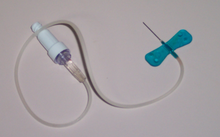Winged cannula
The winged cannula (colloquially also called butterfly or butterfly ) is a special form of cannula . It is used to take blood , but can also be used for short-term intravenous administration of medication or fluid therapy.
The winged cannula consists of a usually very fine cannula, which is provided with two flexible plastic wings and a hose. With the help of the folded plastic wings, the winged cannula can be guided safely and precisely during the puncture . After the puncture, the plastic wings can be folded flat on the skin and fixed with a strip of adhesive plaster . The winged cannula has the advantage of being able to move by moving the Luer lock , e.g. B. when changing blood collection tubes , not to move and is therefore mostly used with very small, fragile veins. The application is also less painful and gentle on veins than with thicker cannulas.
Newer models, Safety-Butterflys, have a protective cover that is pushed over the needle after use and engages in this position. This will help prevent needlestick injuries and the need to reuse needles.
Winged cannulas were initially developed for puncturing the cranial veins in newborns and infants.
Overview and comparison table for the color coding, dimensions and sizes of cannulas
| Pravaz system (size) | 1 | 2 | 12 | 14th | 15th | 16 | 17th | 18th | 20th | 21st | 22nd | 23 | ||||||||||||||
|---|---|---|---|---|---|---|---|---|---|---|---|---|---|---|---|---|---|---|---|---|---|---|---|---|---|---|
| Length according to the Pravaz system | 38 | 35 | 32 | 30th | 26th | 26th | 26th | 23 | 22nd | 20th | 20th | 20th | ||||||||||||||
| Size in gauge (G) | 10 | 11 | 12 | 13 | 14th | 15th | 16 | 17th | 18th | 19th | 20th | 21st | 22nd | 23 | 24 | 25th | 26th | 27 | 28 | 29 | 30th | |||||
| Color according to ISO 6009 or DIN 13095 |
brown- olive |
yellow- green |
white- blue |
purple | white- green |
blue- gray |
White | red- purple |
pink | cream ivory |
yellow | dark green |
black | blue* | * | dark blue |
medium pure |
orange | brown | medium gray |
blue green | red | yellow | * | * | * |
| Outside diameter ( mm ) according to ISO / DIN 9626 |
3.4 | 3.0 | 2.7 | 2.4 | 2.1 | 1.8 | 1.6 | 1.4 | 1.2 | 1.1 | 0.9 | 0.8 | 0.7 | 0.65 * | 0.65 * | 0.60 | 0.55 | 0.50 | 0.45 | 0.40 | 0.36 | 0.33 | 0.30 | 0.28 * | 0.26 * | 0.25 * |
| Charrière / French (Charr., Ch., Fr.) |
10.2 | 9 | 8.1 | 7.1 | 6.3 | 5.4 | 4.8 | 4.2 | 3.6 | 3.3 | 2.7 | 2.4 | 2.1 | 2.0 | 2.0 | 1.8 | 1.65 | 1.50 | 1.35 | 1.20 | 1.09 | 1 | 0.9 | 0.84 | 0.78 | 0.75 |
| common lengths (mm) |
80 | 40 | 40 50 70 |
38 | 30 35 40 50 120 |
16 30 32 |
30th | 26th | 16 26 30 |
26th | 16 24 26 |
10 16 23 |
6, 8, 10, 12, 20 and 22 | |||||||||||||
* The DIN / ISO regulations assign the size specifications in gauge to the outer diameter and the color. As soon as no measurement is given in gauge, the corresponding information in the line is not taken from the DIN / ISO standard;
